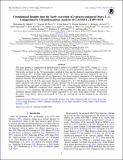| dc.contributor.author | Mardini, Mohammad K | |
| dc.contributor.author | Placco, Vinicius M | |
| dc.contributor.author | Meiron, Yohai | |
| dc.contributor.author | Ishchenko, Marina | |
| dc.contributor.author | Avramov, Branislav | |
| dc.contributor.author | Mazzarini, Matteo | |
| dc.contributor.author | Berczik, Peter | |
| dc.contributor.author | Sedda, Manuel Arca | |
| dc.contributor.author | Beers, Timothy C | |
| dc.contributor.author | Frebel, Anna | |
| dc.contributor.author | Taani, Ali | |
| dc.contributor.author | Donnari, Martina | |
| dc.contributor.author | Al-Wardat, Mashhoor A | |
| dc.contributor.author | Zhao, Gang | |
| dc.date.accessioned | 2022-04-11T18:24:40Z | |
| dc.date.available | 2022-04-11T18:24:40Z | |
| dc.date.issued | 2020 | |
| dc.identifier.uri | https://hdl.handle.net/1721.1/141831 | |
| dc.description.abstract | This study presents a comprehensive chemodynamical analysis of LAMOST J1109+0754, a bright (V = 12.8), extremely metal-poor ([Fe/H] = -3.17) star, with a strong r-process enhancement ([Eu/Fe] = +0.94 ± 0.12). Our results are based on the 7D measurements supplied by Gaia and the chemical composition derived from a high-resolution (R ∼ 110,000), high signal-to-noise ratio (S N ∼ 60) optical spectrum obtained by the 2.4 m Automated Planet Finder Telescope at Lick Observatory. We obtain chemical abundances of 31 elements (from lithium to thorium). The abundance ratios ([X/Fe]) of the light elements (Z ≤ 30) suggest a massive Population III progenitor in the 13.4-29.5M⊙ mass range. The heavy-element (30 < Z ≤ 90) abundance pattern of J1109+075 agrees extremely well with the scaled-solar r-process signature. We have developed a novel approach to trace the kinematic history and orbital evolution of J1109+0754 with a cOsmologically deRIved timE-varyiNg Galactic poTential (the ORIENT) constructed from snapshots of a simulated Milky Way analog taken from the Illustris-TNG simulation. The orbital evolution within this Milky Way-like galaxy, along with the chemical abundance pattern, implies that J1109+0754 likely originated in a low-mass dwarf galaxy located ∼60 kpc from the center of the Galaxy, which was accreted ∼6-7 Gyr ago, and that the star now belongs to the outer-halo population. | en_US |
| dc.language.iso | en | |
| dc.publisher | American Astronomical Society | en_US |
| dc.relation.isversionof | 10.3847/1538-4357/ABBC13 | en_US |
| dc.rights | Article is made available in accordance with the publisher's policy and may be subject to US copyright law. Please refer to the publisher's site for terms of use. | en_US |
| dc.source | The American Astronomical Society | en_US |
| dc.title | Cosmological Insights into the Early Accretion of r -process-enhanced Stars. I. A Comprehensive Chemodynamical Analysis of LAMOST J1109+0754 | en_US |
| dc.type | Article | en_US |
| dc.identifier.citation | Mardini, Mohammad K, Placco, Vinicius M, Meiron, Yohai, Ishchenko, Marina, Avramov, Branislav et al. 2020. "Cosmological Insights into the Early Accretion of r -process-enhanced Stars. I. A Comprehensive Chemodynamical Analysis of LAMOST J1109+0754." Astrophysical Journal, 903 (2). | |
| dc.contributor.department | Massachusetts Institute of Technology. Department of Physics | |
| dc.contributor.department | MIT Kavli Institute for Astrophysics and Space Research | |
| dc.relation.journal | Astrophysical Journal | en_US |
| dc.eprint.version | Final published version | en_US |
| dc.type.uri | http://purl.org/eprint/type/JournalArticle | en_US |
| eprint.status | http://purl.org/eprint/status/PeerReviewed | en_US |
| dc.date.updated | 2022-04-11T18:08:06Z | |
| dspace.orderedauthors | Mardini, MK; Placco, VM; Meiron, Y; Ishchenko, M; Avramov, B; Mazzarini, M; Berczik, P; Sedda, MA; Beers, TC; Frebel, A; Taani, A; Donnari, M; Al-Wardat, MA; Zhao, G | en_US |
| dspace.date.submission | 2022-04-11T18:08:10Z | |
| mit.journal.volume | 903 | en_US |
| mit.journal.issue | 2 | en_US |
| mit.license | PUBLISHER_POLICY | |
| mit.metadata.status | Authority Work and Publication Information Needed | en_US |
